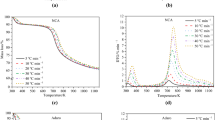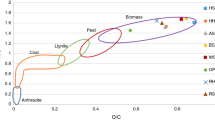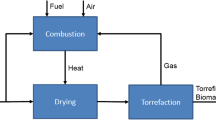Abstract
Microwave-assisted cracking is an emerging technique for biomass tar elimination, but lacks the artificial intelligence application for predicting the elimination efficiency and the optimal multi-correlated reaction conditions. In this work, we investigated the microwave-assisted cracking of a biomass tar model compound at various operating conditions and established a back propagation (BP) neural network based on the realistic experimental data to predict the highest elimination performance and obtain the corresponding optimal operation parameters. Results show that the xylene elimination efficiency increases monotonically with reaction temperature (Tr) at 600–850 °C and inlet xylene concentration (Cx) of 38.4 to 42.2 g/m3. It is also affected by gas hourly space velocity (GHSV) but rarely influenced by the SiC particle diameter (d). The xylene was mainly cracked into methane and toluene, and the cracking reactions involve both direct decomposition and radical-induced cracking. Based on a three-layer BP model, the highest xylene elimination efficiency was predicted to be 95.7%, and the main optimal parameters including Tr, GHSV, Cx, and d are 800 °C, 27.3 h−1, 38.4 g/m3, and 1 mm, respectively. The predicted result shows a good accuracy after experimental validation.
Graphical abstract










Similar content being viewed by others
References
Li C, Suzuki K (2009) Tar property, analysis, reforming mechanism and model for biomass gasification—an overview. Renew Sustain Energy Rev 13:594–604. https://doi.org/10.1016/j.rser.2008.01.009
Gredinger A, Spörl R, Scheffknecht G (2018) Comparison measurements of tar content in gasification systems between an online method and the tar protocol. Biomass Bioenergy 111:301–307. https://doi.org/10.1016/j.biombioe.2017.01.026
Torres W, Pansare SS, Goodwin JG (2007) Hot gas removal of tars, ammonia, and hydrogen sulfide from biomass gasification gas. Catal Rev 49:407–456. https://doi.org/10.1080/01614940701375134
Valderrama Rios ML, González AM, Lora EES, Almazán del Olmo OA (2018) Reduction of tar generated during biomass gasification: a review. Biomass Bioenergy 108:345–370. https://doi.org/10.1016/j.biombioe.2017.12.002
Anis S, Zainal ZA (2011) Tar reduction in biomass producer gas via mechanical, catalytic and thermal methods: a review. Renew Sustain Energy Rev 15:2355–2377. https://doi.org/10.1016/j.rser.2011.02.018
Zhang X, Chen Z, Cheng L, Xu L, Bi X, Liu Q (2022) Valorization of fluid petroleum coke for efficient catalytic destruction of biomass gasification tar. J Hazard Mater 424:127297. https://doi.org/10.1016/j.jhazmat.2021.127297
Li X, Liu P, Chen W, Wu Y, Lei T, Huang S, Li Y, Wu S, Wang Z (2022) Catalytic pyrolysis of toluene as biomass tar model component using Ni/HZSM-5 modified by CeO2 and MgO promoters. J Anal Appl Pyrolysis 162:105436. https://doi.org/10.1016/j.jaap.2022.105436
Heidenreich S, Foscolo PU (2015) New concepts in biomass gasification. Prog Energy Combust Sci 46:72–95. https://doi.org/10.1016/j.pecs.2014.06.002
Janajreh I, Raza SS, Valmundsson AS (2013) Plasma gasification process: modeling, simulation and comparison with conventional air gasification. Energy Convers Manag 65:801–809. https://doi.org/10.1016/j.enconman.2012.03.010
Li J, Tao J, Yan B, Jiao L, Chen G, Hu J (2021) Review of microwave-based treatments of biomass gasification tar. Renew Sustain Energy Rev 150:111510. https://doi.org/10.1016/j.rser.2021.111510
Motasemi F, Afzal MT (2013) A review on the microwave-assisted pyrolysis technique. Renew Sustain Energy Rev 28:317–330. https://doi.org/10.1016/j.rser.2013.08.008
Beneroso D, Bermúdez JM, Montes-Morán MA, Arenillas A, Menéndez JA (2016) Microwave-induced cracking of pyrolytic tars coupled to microwave pyrolysis for syngas production. Bioresour Technol 218:687–691. https://doi.org/10.1016/j.biortech.2016.07.019
Yin C (2012) Microwave-assisted pyrolysis of biomass for liquid biofuels production. Bioresour Technol 120:273–284. https://doi.org/10.1016/j.biortech.2012.06.016
Kappe CO (2004) Controlled microwave heating in modern organic synthesis. Angew Chem Int Ed 43:6250–6284. https://doi.org/10.1002/anie.200400655
Bilecka I, Niederberger M (2010) Microwave chemistry for inorganic nanomaterials synthesis. Nanoscale 2:1358–1374. https://doi.org/10.1039/B9NR00377K
Muley PD, Henkel CE, Aguilar G, Klasson KT, Boldor D (2016) Ex situ thermo-catalytic upgrading of biomass pyrolysis vapors using a traveling wave microwave reactor. Appl Energy 183:995–1004. https://doi.org/10.1016/j.apenergy.2016.09.047
Guo F, Dong Y, Tian B, Du S, Liang S, Zhou N, Wang Y, Chen P, Ruan R (2020) Applications of microwave energy in gas production and tar removal during biomass gasification. Sustainable Energy Fuels 4:5927–5946. https://doi.org/10.1039/D0SE01024C
Beneroso D, Bermúdez JM, Arenillas A, Menéndez JA (2015) Comparing the composition of the synthesis-gas obtained from the pyrolysis of different organic residues for a potential use in the synthesis of bioplastics. J Anal Appl Pyrolysis 111:55–63. https://doi.org/10.1016/j.jaap.2014.12.011
Zhang Y, Chen P, Liu S, Peng P, Min M, Cheng Y, Anderson E, Zhou N, Fan L, Liu C, Chen G, Liu Y, Lei H, Li B, Ruan R (2017) Effects of feedstock characteristics on microwave-assisted pyrolysis - a review. Bioresour Technol 230:143–151. https://doi.org/10.1016/j.biortech.2017.01.046
Ethaib S, Omar R, Kamal SMM, Awang Biak DR, Zubaidi SL (2020) Microwave-assisted pyrolysis of biomass waste: a mini review. Processes 8:1190. https://doi.org/10.3390/pr8091190
Li J, Jiao L, Tao J, Chen G, Hu J, Yan B, Mansour M, Guo Y, Ye P, Ding Z, Yu T (2020) Can microwave treat biomass tar? A comprehensive study based on experimental and net energy analysis. Appl Energy 272:115194. https://doi.org/10.1016/j.apenergy.2020.115194
Li J, Tao J, Yan B, Cheng K, Chen G, Hu J (2020) Microwave reforming with char-supported nickel-cerium catalysts: a potential approach for thorough conversion of biomass tar model compound. Appl Energy 261:114375. https://doi.org/10.1016/j.apenergy.2019.114375
Zhang Y, Song Z, Yan Y, Zhao X, Sun J, Mao Y, Wang W (2018) Performance of Fe/SiC catalysts for cracking of toluene under microwave irradiation. Int J Hydrogen Energy 43:7227–7236. https://doi.org/10.1016/j.ijhydene.2018.02.158
Chen G, Li J, Cheng Z, Yan B, Ma W, Yao J (2018) Investigation on model compound of biomass gasification tar cracking in microwave furnace: comparative research. Appl Energy 217:249–257. https://doi.org/10.1016/j.apenergy.2018.02.028
Pallavkar S, Kim TH, Lin J, Hopper J, Ho T, Jo HJ, Lee JH (2010) Microwave-assisted noncatalytic destruction of volatile organic compounds using ceramic-based microwave absorbing media. Ind Eng Chem Res 49:8461–8469. https://doi.org/10.1021/ie1009734
Ding S, Li H, Su C, Yu J, Jin F (2013) Evolutionary artificial neural networks: a review. Artif Intell Rev 39:251–260. https://doi.org/10.1007/s10462-011-9270-6
Rosli MN, Aziz N (2016) Review of neural network modelling of cracking process. 2016 IOP Conf Ser: Mater Sci Eng 162:01. https://doi.org/10.1088/1757-899X/162/1/012016
Li J, Yao X, Xu K (2021) A comprehensive model integrating BP neural network and RSM for the prediction and optimization of syngas quality. Biomass Bioenergy 155:106278. https://doi.org/10.1016/j.biombioe.2021.106278
Liang W, Wang G, Ning X, Zhang J, Li Y, Jiang C, Zhang N (2020) Application of BP neural network to the prediction of coal ash melting characteristic temperature. Fuel 260:116324. https://doi.org/10.1016/j.fuel.2019.116324
Wu D, Zhang D, Liu S, Jin Z, Chowwanonthapunya T, Gao J, Li X (2020) Prediction of polycarbonate degradation in natural atmospheric environment of China based on BP-ANN model with screened environmental factors. Chem Eng J 399:125878. https://doi.org/10.1016/j.cej.2020.125878
Long J, Li T, Yang M, Hu G, Zhong (2019) Hybrid strategy integrating variable selection and a neural network for fluid catalytic cracking modeling. Ind Eng Chem Res 58:247-258.https://doi.org/10.1021/acs.iecr.8b04821
Sedighi M, Keyvanloo K, Towfighi J (2011) Modeling of thermal cracking of heavy liquid hydrocarbon: application of kinetic modeling, artificial neural network, and neuro-fuzzy models. Ind Eng Chem Res 50:1536–1547. https://doi.org/10.1021/ie1015552
Nabavi R, Niaei A, Salari D, Towfighi J (2007) Modeling of thermal cracking of LPG: application of artificial neural network in prediction of the main product yields. J Anal Appl Pyrolysis 80:175–181. https://doi.org/10.1016/j.jaap.2007.01.015
Sun Y, Liu L, Wang Q, Yang X, Tu X (2016) Pyrolysis products from industrial waste biomass based on a neural network model. J Anal Appl Pyrolysis 120:94–102. https://doi.org/10.1016/j.jaap.2016.04.013
Ethaib S, Omar R, Mazlina MKS, Radiah ABD, Syafiie S (2018) Development of a hybrid PSO–ANN model for estimating glucose and xylose yields for microwave-assisted pretreatment and the enzymatic hydrolysis of lignocellulosic biomass. Neural Comput Appl 30:1111–1121. https://doi.org/10.1007/s00521-016-2755-0
Kostyniuk A, Grilc M, Likozar B (2019) Catalytic cracking of biomass-derived hydrocarbon tars or model compounds to form biobased benzene, toluene, and xylene isomer mixtures. Ind Eng Chem Res 58:7690–7705. https://doi.org/10.1021/acs.iecr.9b01219
Szwarc M (1948) The C-H bond energy in toluene and xylenes. J Chem Phy 16:128–136. https://doi.org/10.1063/1.1746794
Simell PA, Hepola JO, Krause AOI (1997) Effects of gasification gas components on tar and ammonia decomposition over hot gas cleanup catalysts. Fuel 76:1117–1127. https://doi.org/10.1016/S0016-2361(97)00109-9
Anis S, Zainal ZA, Bakar MZA (2013) Thermocatalytic treatment of biomass tar model compounds via radio frequency. Bioresour Technol 136:117–125. https://doi.org/10.1016/j.biortech.2013.02.049
Safarik I, Strausz OP (1997) The thermal decomposition of hydrocarbons. Part 2 Alkylaromatic Hydrocarbons: alkylbenzenes. Res Chem Intermed 23:63–99. https://doi.org/10.1163/156856797X00402
Chen Z, Zhang X, Liu Z, Liu Q, Xu T (2018) Quantification of reactive intermediate radicals and their induction effect during pyrolysis of two n-alkylbenzenes. Fuel Process Technol 178:126–132. https://doi.org/10.1016/j.fuproc.2018.05.025
Schaefgen JR (1955) The pyrolysis of p-xylene. J Polymer Sci 15:203–219. https://doi.org/10.1002/pol.1955.120157917
Feng Y, Liu Y, Wang X, He Z, Hung T, Wang Q, Xi H (2020) Performance prediction and optimization of an organic rankine cycle (ORC) for waste heat recovery using back propagation neural network. Energy Convers Manag 226:113552. https://doi.org/10.1016/j.enconman.2020.113552
Funding
This work was mainly funded by the Huzhou Science and Technology Project (No. 2020GZ28) and partly funded by the Zhejiang Basic Public Welfare Research Project (No. LGF22E080025).
Author information
Authors and Affiliations
Contributions
Yu Chen: methodology; investigation; BP model establishment; writing—original draft. Cheng Yang: experimental data collection; formal analysis. Kanfeng Ying: visualization; material preparation. Fan Yang: data curation. Lei Che: validation, resources. Zezhou Chen: conceptualization; writing—review and editing; supervision; project administration. All authors have read and approved the final manuscript.
Corresponding author
Ethics declarations
Conflict of interest
The authors declare no competing interests.
Additional information
Publisher's note
Springer Nature remains neutral with regard to jurisdictional claims in published maps and institutional affiliations.
Supplementary Information
Below is the link to the electronic supplementary material.
Rights and permissions
About this article
Cite this article
Chen, Y., Yang, C., Ying, K. et al. Prediction on microwave-assisted elimination of biomass tar using back propagation neural network. Biomass Conv. Bioref. 14, 7927–7937 (2024). https://doi.org/10.1007/s13399-022-02834-1
Received:
Revised:
Accepted:
Published:
Issue Date:
DOI: https://doi.org/10.1007/s13399-022-02834-1




